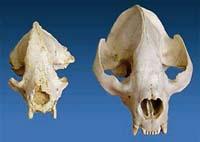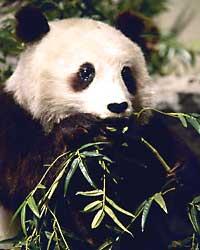Large carnivorous and herbivorous panda at the same time
2010/01/17 Kortabitarte Egiguren, Irati - Elhuyar Zientzia

Researchers at the Beijing Genomics Institute have sequenced the genome and found that meat contains all the genes to digest, but not everything necessary to digest, bamboo with staple food. In fact, they have not found cellulose enzyme genus. Therefore, intestinal bacteria are necessary for the digestion of cellulose. In addition, thanks to these bacteria or microorganisms is the herbivore panda. Panda only eats bamboo. Because bamboo is low in nutrients, panda plants spend about 14 hours a day filling the stomach.
In addition, they have found that the receptor gene for meat flavor is mutated. Therefore, this may explain that, despite being a carnivorous panda, it is herbivore.

According to the article published in the journal Nature, the large panda contains approximately 21,000 genes. Among the mammals that have sequenced so far, the dog stands out (80%). With man, on the other hand, it only resembles 68%. However, panda genetics have undergone fewer changes than dog and human genetics. And it has evolved more slowly.
They have also seen that it has a great genetic diversity, twice as much as human. Therefore, it remains likely to survive despite the small population. In addition, this type of research should be useful in developing strategies to control the diseases of the species and to preserve it.
Endangered

Panda's situation is really serious. The population has declined in recent years. Currently only 2,500-3,000 large panda remain worldwide, especially in the eastern mountains of China.
They are little breeding animals: the female has only one breeding every 2-3 years. In addition, the wild panda population has fallen by half in the last two decades, which means a decrease in the chances of finding a partner. And when they take the zoos, they reproduce even less. They seem to lose passion for sex. In addition, for years they have been surrendered. Mainly for these two reasons, the population has declined considerably and numerous attempts at recovery have failed, among other reasons, because large panda shows no interest in reproduction. However, the researchers do not give up, and this time, with the sequencing of their genome, they have wanted to make a last attempt to conserve the pandas. It would be a grief and a loss of the species.
Many can meet panda (Ailuropoda melanoleuca) because it is the symbol of the organization WWF. In fact, the organization has taken advantage of the image of this animal to warn the public that some species are in danger of extinction and that it is necessary to protect them and their place of residence. One of them is the Big Panda. It is in danger or in danger of extinction due to the progressive decrease of its residence and the low birth rate, among others. The future of your black and white panda is unforgettable.
Published in 7k

Gai honi buruzko eduki gehiago
Elhuyarrek garatutako teknologia





